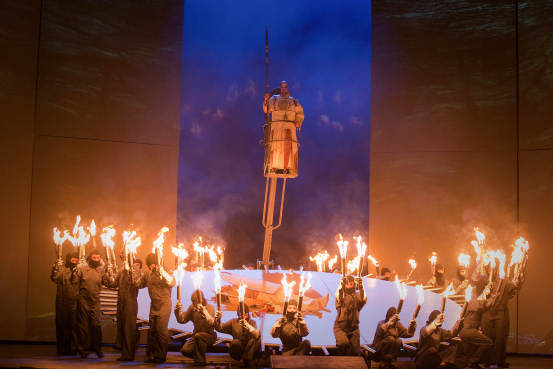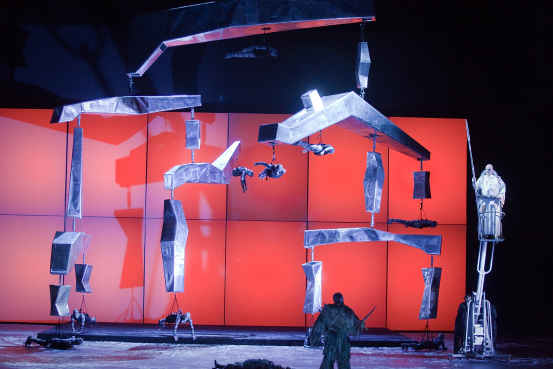Other Links
Editorial Board
-
Editor - Bill Kenny
-
Deputy Editor - Bob Briggs
Founder - Len Mullenger
Google Site Search
SEEN AND HEARD
INTERNATIONAL OPERA REVIEW
The Valencia Ring - Wagner, Die Walküre: Soloists, Orquesta de la Comunitat Valenciana, Conductor: Zubin Mehta. Palau de les Arts de Valencia. 16.6.2009 (JMI)
Production: Palau de les Arts de Valencia and Maggio Musicale Fiorentino.
Director: La Fura dels Baus. Carlus Padrissa.
Sets: Roland Olbeter.
Costumes: Chu Uroz.
Lighting: Peter Van Praet.
Videos: Franc Aleu.
Cast:
Brünnhilde: Jennifer Wilson.
Siegmund: Torsten Kerl.
Sieglinde: Eva-Maria Westbroek.
Wotan: Juha Uusitalo.
Hunding: Matti Salminen.
Fricka: Anna Larsson.
Gerhilde: Bernadette Flaitz.
Ortlinde: Elena Pankratova.
Waltraute: Pilar Vázquez.
Schwertleite: María Luisa Corbacho.
Helmwige: Eugenia Bethencourt.
Siegrune: Marina Prudenskaya.
Grimgerde: Manuela Bress.
Rossweisse: Daniela Denschlag.

It is a very great pleasure indeed to leave an opera house with the feeling of having attended a very special performance. Opera is a spectacle that needs all its ingredients to be of the highest quality in order achieve excellence and sometimes of course, it happens that all the ingredients are good, but the mixture of them fails to satisfy the demanding and differing tastes of the consumers. Some give most importance to the notes in the score, whereas others value over only particular interpretations. Then there are some who think the voices are the top priority, while some feel transported by the stage show. Since all these ingredients demand different doses for different consumers, there is astonishing difficulty in obtaining a generalised triumph.
In this Walküre we had a final product of outstanding quality and the balance of ingredients seems to have suited most people. There was a magnificent orchestra, brilliant musical direction, an attractive and respectful production and, finally, a cast of the first order, one that would be welcomed by any of the great opera houses worldwide. It might even be fair to say that the great days of Bayreuth have been transferred to the Mediterranean by this production.

After the Palau’s Rheingold, I was expecting the continuation of the tetralogy with another set of imaginative projections from La Fura dels Baus and its director Carlus Padrissa, more cranes and more new ideas. To a great extent that’s what we had, although on a smaller scale than what we were offered - especially with the projections - the previous day. There was another bare stage with a big screen at the back, up which the ash tree was projected in the first act. La Fura presented the meeting of the twins as an encounter between homo sapiens and Neanderthal: Sieglinde moved around on all fours until Siegmund raised her to a standing position at the arrival of Spring when she became - or perhaps reverted to being -fully human again after her imprisonment by Hunding. In Act II, we were back to cranes and baskets on stage and the confrontation between Wotan-Fricka, both in baskets, lost some interest. Wotan’s monologue, used thecrane/bucket idea as a kind of psychiatrist’s couch, and was more convincing, making very good use of some of the previous day’s Rheingold projections. For the announcement of Siegmund’s death, Brünnhilde came to the stage surrounded by metal elements that were raised for the battle at the end of the act. The Ride of the Valkyries, four in buckets and four on the floor, was not too convincing either. The magic fire was shown as a platform (the rock) with the a troupe from La Fura around it holding balzing torches. In summary though, this was an imaginative production, with many original ideas, which was always respectful to the score and the libretto.
As in Das Rheingold, Zubin Mehta’s reading was both magnificent and brilliant, with the addition of an exceptional performance from his splendid orchestra There were moments - or rather sustained passage - that were truly magical. The first half hour probably ranks with the best recorded live and for me it was the best I have heard in years, although the Wälsungs love duet remained - in my personal evaluation - slightly short of inspiration and emotion. Mehta was at his best again though in ActII; excellent at Wotan’s monologue and the death announcement. The Valkyries’ Ride was not as bright as one might have expected, but the opera ended with magic fire music that was…well, magic. Overall, this was a great Walküre from a musical point of view, served by a magnificent orchestra in the hands service of a brilliant maestro.
The Wälsung twins were new from two years ago. At the premiere they were Peter Seiffert and Petra Maria Schnitzer. This time the Siegmund was German tenor Torsten Kerl, who has gave a performance that was more powerful and bright than nuanced and moving. He was best in Act II, where he was excellent. In Act I he was more uneven, with a breathless “Wälse” that lasted an eternity and a very fine finale, while in the love duet he was short on expressiveness and emotionality. After this performance, it will be very interesting to see him in Rienzi in Berlin next January.
The Dutch soprano Eva-Maria Westbroek was a very good Sieglinde in every respect. The voice is wide, well projected, powerful and in addition she is a great actress - without a doubt, one of the very best today in the role. The only slight problem that I noticed had to do with some less than brilliant notes in the highest register.
The American Jennifer Wilson, repeated her Brünnhilde and was again excellent. Surely she is today the brightest soprano at the “Hojo to Hos”, with high notes that are like whiplashes, full of power and pitched exactly righ. Slightly short of emotion in the great scene with Wotan in Act III In general, she was a very good Walküre, although I found her this time somehow weaker at the bottom end of her range than two years ago. She is much better suited for Die Walküre than for Götterdämmerung (see recent review.)
Juha Uusitalo has improved his interpretation of Wotan in the past two years. He was an imposing and convincing god, perhaps a little short on power, but much more matured than on the earler occasion. I enjoyed him greatly in the monologue whereas in the “Leb’ wohl” he did not quite reach the pinnacle of emotion of James Morris at his best or of Albert Dohmen.
Matti Salminen is the Hunding of reference these days (René Pape permitting). There is nothing else to be said of him, besides recognizing that his vast artistry is as big as his voice. Anna Larsson was a very interesting Fricka, remarkably better than two years ago whose attractive figure goes almost unnoticed in this production. The voice is good in the middle and bottom, while the top is not of the same quality. Even so, she gave a first rate interpretation of the confrontation with Wotan.
The collection of Valkyries was impressive in terms of power and musicality - probably the most successful group I have seen on stage until now. Clearly, this is a cast selected with a great care which in itself is worthy of much praise.
There was a completely full house again with cheers and ovations for the singers, and of course for Zubin Mehta and the orchestra. Everything finished with a “Standing ovation” which was totally deserved. All the fireworks were inside the theatre this time.
José M Irurzun
Pictures © Palau de Les Arts, Valencia
Back to Top
Cumulative Index Page
